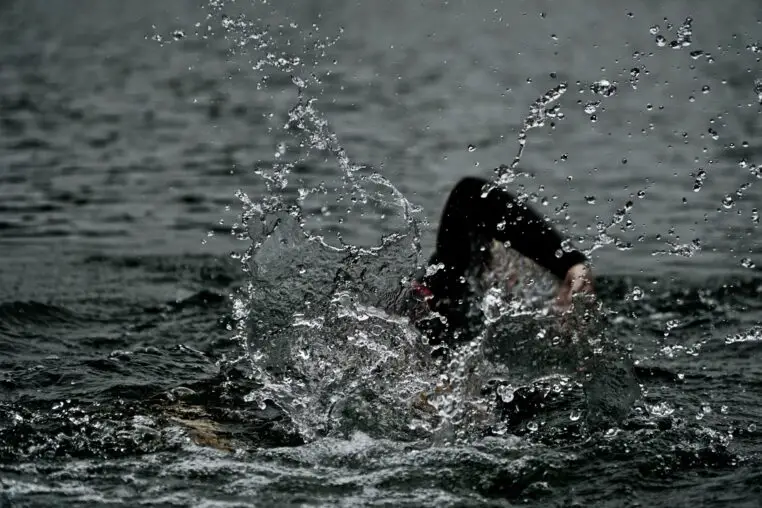
We’ve all been there – a seemingly warm day entices you to take a refreshing swim, but once you’re in the water, it feels a lot cooler than expected.
So, is 75 degrees outside too cold to swim? The answer isn’t always straightforward. This article delves into the factors influencing the perfect swimming temperature, exploring air and water temperatures, individual tolerance, and the impact of wind and rain.
Is 75 Degrees Outside Too Cold for Swimming?

When determining if 75 degrees Fahrenheit is suitable for swimming, it’s crucial to consider both air and water temperatures. While 75-degree weather may sound inviting, it doesn’t guarantee an ideal swim because water temperature plays a significant role.
Typically, water cooler than 60 degrees Fahrenheit can pose risks to swimmers staying in for extended periods. While 75-degree weather doesn’t necessarily mean 75-degree water, water temperature should trend toward the air temperature, making it considerably warmer than 60 degrees.
The preferred water temperature for swimming usually falls between 77 and 82 degrees Fahrenheit for most individuals. However, personal preferences, body fat percentages, and age can affect one’s ability to tolerate various temperatures. It’s also essential to consider other environmental factors like wind and humidity.
While 75-degree air temperature may feel comfortable, swimming conditions may differ, depending on these elements. Wind or low humidity can make the water seem colder when you exit, emphasizing the importance of having towels and warm clothing ready after swimming.
The Relationship Between Outdoor and Pool Temperature
Several factors influence the connection between outdoor and pool water temperature:
a. Heat Capacity
Water has a higher heat capacity than air, meaning it changes temperature more slowly. Thus, pool water heats up or cools down at a different rate than the air.
b. Solar Radiation
Sunlight plays a crucial role in heating pool water. Even on cooler days, a pool can be warmer than the surrounding air, especially during sunny periods when the sun’s rays penetrate and warm the water.
c. Evaporation
Evaporation cools pool water as surface water evaporates, taking heat with it. This effect is more pronounced on hot, dry, and windy days.
d. Wind and Rain
Wind increases evaporation, cooling the pool’s surface water. Rain can also affect pool temperature, as rainwater is often cooler than pool water.
e. Pool Size and Depth
The pool’s size and depth influence how quickly it changes temperature, with smaller, shallower pools reacting more rapidly.
f. Pool Cover
A pool cover helps maintain heat and reduces evaporation, making it an essential accessory, especially in colder climates.
Given these complexities, it’s best to focus on pool or water temperature, as it offers a more accurate picture of swimming conditions.
Can 75-degree Weather Lead to Hypothermia?
A common misconception is that 75-degree weather means comfortable swimming conditions. However, 75-degree water can still feel cool, particularly as water is more efficient at conducting heat away from the body compared to air.
Consequently, hypothermia, where body temperature drops below 95°F (35°C), can occur in moderately warm water, especially if it’s windy.
To mitigate cold shock and hypothermia risks, consider wearing a wetsuit when swimming outdoors. Wetsuits insulate the body and aid buoyancy. If a wetsuit is unavailable, limit your time in the water to reduce exposure.
What Does 75-degree Water Feel Like?
Water at 75 degrees Fahrenheit might initially feel slightly cool, especially when transitioning from a warmer environment. However, once you’re in the water and active, your body typically adapts, making the water feel comfortable and refreshing.
Sensitivity to water temperature varies among individuals. Some may find 75-degree water slightly chilly, while others consider it perfect, especially on hot days. Pre-swim activities can also influence how you perceive the water’s temperature. If you’re warm and sweaty, the water may feel refreshing, but if you’ve been in an air-conditioned environment, it might seem colder.
While 75-degree water can be comfortable initially, extended exposure can lead to a drop in body temperature, making you feel chilled.
Wind Chill Factor and Its Impact
The wind chill factor accounts for the air temperature and wind speed, influencing how cold the weather feels due to heat loss. For swimmers, both the water temperature and the wind chill factor should be considered.
A 75-degree day can feel cooler if windy, potentially leading to discomfort and increased heat loss. If it’s windy and you lack a wetsuit or insulating layer, think twice about swimming.
Is 75-degree Weather Suitable for Children and the Elderly?

While 75-degree weather may be comfortable for most adults and young children, it might not be ideal for small children or the elderly due to differing body sensitivities. Older adults are generally more sensitive to cold, increasing the risk of health problems if exposed to lower temperatures.
To be cautious, particularly with vulnerable demographics, consider not swimming or wearing a wetsuit in 75-degree weather. If you have your pool, aim for a water temperature of at least 78 degrees Fahrenheit, generally considered safe for swimming.
Swimming in Natural Water Bodies
Natural water bodies like seas and lakes can have varied temperatures. Water temperatures from 78 to 86 degrees Fahrenheit are considered pleasant and safe for moderate physical activities like swimming.
Keep in mind that water temperatures in different areas can vary, affecting your swimming experience. Water at certain beaches may remain cool, even on warm days, especially when the sun hasn’t had enough time to warm it up.
Additionally, consider temperature variations with depth and flow, as deeper water and flowing currents tend to be cooler. Always check water conditions and temperatures when swimming in natural water bodies.
Suitable Swimwear for 75-degree Weather
When the air temperature is around 75 degrees, choose swimwear that provides warmth and coverage without restricting movement. Wetsuits are excellent options, as they insulate the body and maintain comfortable water temperatures during activities. Several wetsuit thickness options are available to cater to different preferences and swimming conditions.
In addition to wetsuits, consider neoprene accessories such as socks, gloves, and caps. These items provide the same benefits as wetsuits for your feet, hands, and head, respectively.
Ideal Outdoor Swimming Temperature
For maximum comfort and safety, aim for water temperatures ranging from 78 to 86 degrees Fahrenheit. On a 75-degree day, consider the influence of environmental factors like wind and humidity, and monitor your comfort while swimming. If you feel too cold or start shivering, take a break to warm up.
For those with heated pools, maintaining the desired water temperature is easier, but outdoor swimmers should acclimate slowly to the water and adjust their swimming accordingly.
Conclusion
Understanding the relationship between air and water temperature, wind, and individual tolerance levels is essential when deciding if 75 degrees outside is suitable for swimming. Prioritize safety, especially for children, the elderly, and those in windy conditions, by wearing appropriate swimwear and monitoring your comfort levels while enjoying a refreshing swim.









